01 Digital Elevation Models (DEM)
INTRODUCTION
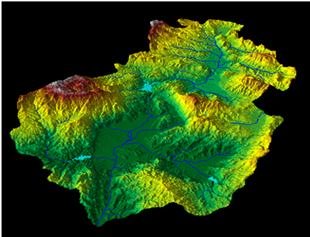 A DEM is a raster representation of the Altitude provide basic, quantitative
information about the Earth’s surface.
The accuracy of this data is determined
primarily by the resolution (the distance
between sample points). Other factors affecting accuracy are data type (integer or floating point) and the actual sampling of the surface when creating the
original DEM.
A DEM is a raster representation of the Altitude provide basic, quantitative
information about the Earth’s surface.
The accuracy of this data is determined
primarily by the resolution (the distance
between sample points). Other factors affecting accuracy are data type (integer or floating point) and the actual sampling of the surface when creating the
original DEM.
Most data providers and professional users use the
term DEM for both the digital terrain model (DTM)
and digital surface model (DSM). A DTM usually refers to the physical
surface of the Earth (elevations of the bare
ground surface) without objects such as vegetation or buildings, while a
DSM describes the
upper surface of the landscape, includes the
height of vegetation, man-made structures and other
surface features, and only gives elevations of the terrain in areas
where there is little or no ground cover (Maune, 2007).
Elevation data sets, from which
DEMs are generated, are obtained by a broad range of measurement techniques, such
as ground survey (GPS,
total station, terrestrial,
and laser scanner), airborne photogrammetric imagery, airborne laser scanning (LiDAR),
radar altimetry and interferometric synthetic
aperture radar (InSAR).
TERMINOLOGY
Digital Elevation Model (DEM):
generic term for altitude grid.
Digital Terrain Model (DTM): ground elevation model.
Digital Surface Model (DSM): ground + cover
elevation model.
Digital Height Model (DHM): cover elevation model.
The digital elevation
model corresponds to a regular grid of elevation. Each node of
the grid shows an altitude value.
The resolution of the grid corresponds to the distance between to neighbor nodes.
DEM Scales Vs Sources
Global Scale
 The GTOPO30 DEM
was created based on heterogeneous topographical
maps. The quality of the elevation
data varies consequently over space.
The GTOPO30 DEM
was created based on heterogeneous topographical
maps. The quality of the elevation
data varies consequently over space.
The SRTM30 DEM
was acquired through space shuttle radar
interferometry. This new source of elevation data overcome the major quality problems of the GTOPO30.
They both present a resolution
of 30 arc seconds (~900 m) and are freely available for the Earth surface.
Regional
Scale
They present a
resolution of 3 arc seconds (~90 m) respectively
1 arc seconds (~30 m) and are available for the Earth surface.
The SRTM 90 m is freely available. The
SRTM 30 m costs being of
0.5 $ per
square kilometer.
Local Scale
(LASER DEM)
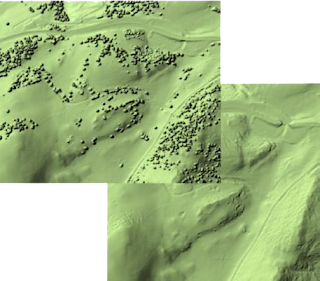 This new acquisition technology allows the capture of very high resolution DEM (~1 m). Both terrain
(ground) and surface (objects) are captured in the same time. Such detailed digital elevation model offers good potential for local relief analysis in applications such as hydrology, hazard mapping. The cost of acquisition are relatively high (150-300$ per
square kilometer).
This new acquisition technology allows the capture of very high resolution DEM (~1 m). Both terrain
(ground) and surface (objects) are captured in the same time. Such detailed digital elevation model offers good potential for local relief analysis in applications such as hydrology, hazard mapping. The cost of acquisition are relatively high (150-300$ per
square kilometer).
(LASER DEM)
The ASTER GDEM is
provided at a one arc-second resolution (approximately
30m). The absolute
vertical accuracy of ASTER GDEM is 20 m
at 95% confidence level.
(ASTER GDEM2)
was introduced to improve the spatial resolution, and increase
the accuracy of water body coverage.
The Global
Multi-resolution Terrain Elevation Data 2010 (GMTED2010) was
generated at three separate resolutions of 30 arc-seconds,
15 arc-seconds, and 7.5
arc-seconds (approximately 1 km, 500 m and 250 m,
respectively).
Examples of the topography detail displayed by
the selected digital elevation models.
Usage of DEM
(1) Hydrological modelling including flood
simulation, delineation and analysis of watersheds and drainage networks,
(2) Soil erosion and sediment transport
modelling,
(3) Delineation and study of physiographic
units,
(4) Soil and ecological studies,
(5) Geomorphological evaluation of landforms,
(6) Civil engineering and military applications
such as site and route selection, landslide hazard assessment, visibility
analysis (viewshed analysis), and
(7) Remotely sensed image enhancement for 3D
analysis. Groundwater and climatic models also use digital topographic data as
essential components. Digital elevation models provide an opportunity to
characterize quantitatively land surface in terms of slope gradient and
curvature and yield digital terrain information not blurred by land cover
features which is often a problem in stereo-aerial photograph interpretation
and remotely sensed image analysis.
Displaying
Digital Elevation Model (DEM)/ (DTM)
Analyzing
Surfaces Terrain / DEM analysis tools
Some of these
tools are primarily designed for the analysis of raster terrain surfaces. These
include Slope, Aspect, Hillshade, and Curvature tools.
1. Calculating
Slope
It affects where structures or trails can be
built, crops can be planted or harvested, the speed of flowing water and
consequent erosion, landslide potential, and the list just goes on and on.
The Slope tool calculates the maximum rate of change from
a cell to its neighbors, which is typically used to
indicate the steepness of terrain. (0-90)
degree.
2. Calculating
Aspect
Aspect identifies the slope
direction in compass degrees from 0 (due
north) to 360.
The aspect of a surface typically affects
the amount of sunlight it receives (as does the slope); in northern
latitudes places with a southerly aspect tends to be warmer and drier than
places that have a northerly aspect. Aspect is an important contributor to vegetation
and habitat type, as north-facing slopes often have very different
conditions and temperatures than south-facing slopes.
3. Hillshade
Hillshade allows us to determine the
illumination of a surface (the DEM in the case) given
a direction and angle of a light source (i.e. the sun). The resultant
grid contains values ranging from 0-255 with
0
representing complete darkness.
Hillshading is an extremely useful
way to depict the topographic relief of a landscape. Few methods are as
intuitive and easy to understand as a hillshade. A good hillshade lets you
understand immediately what areas are ravines, ridges, peaks or valleys.
4. Curvature
Calculates the slope of the slope (the second derivative of the surface), that is,
whether a given part of a surface is convex or concave. Convex parts
of surfaces, like ridges, are generally exposed and
drain to other areas. Concave parts of surfaces, like channels, are
generally more sheltered and accept drainage from other areas.
The Curvature tool has a couple of optional variants, Plan and Profile
Curvature. These are used primarily to interpret the effect of terrain on water
flow and erosion. The profile curvature affects the acceleration and
deceleration of flow, which influence erosion and deposition. The planiform
curvature influences convergence and divergence of flow.
Note
From an applied viewpoint, the output of the
Curvature tool can be used to describe the physical characteristics of a
drainage basin in an effort to understand erosion and runoff processes. The
slope affects the overall rate of movement down-slope. Aspect defines the
direction of flow. The profile curvature affects the acceleration and
deceleration of flow and, therefore, influences erosion and deposition. The
plan form curvature influences convergence and divergence of flow.
Displaying contours over a raster may help with
understanding and interpreting the data resulting from the execution of the
Curvature tool. An example of the process follows >>
1. Use
Contour to create contours of the raster.
2. Create
a slope raster.
3. Contours
of the slope.
4. Add
the curvature raster as a layer in ArcMap. Overlay the two contour coverage just created, and apply different color symbology for each.
Sources
A book of "DTM Principles and Methodology"
Arc GIS online Courses

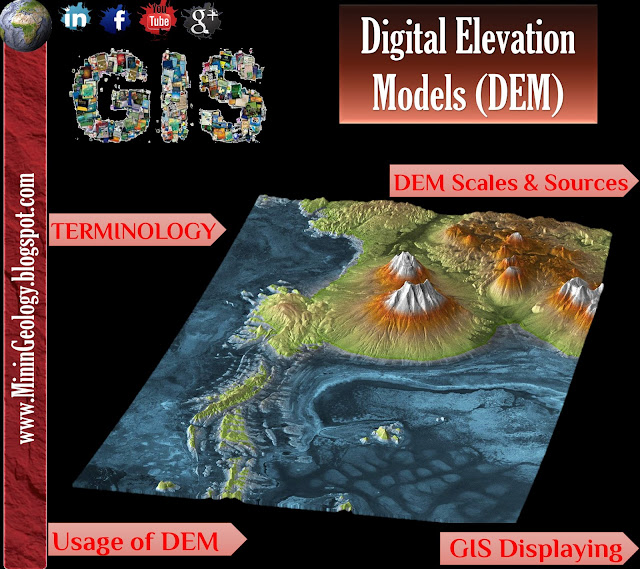









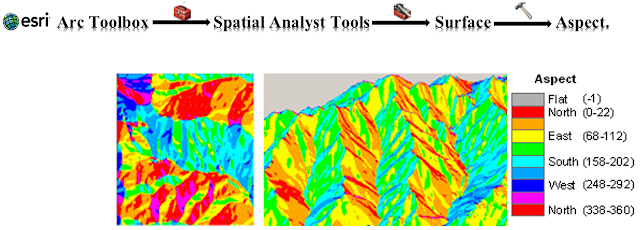

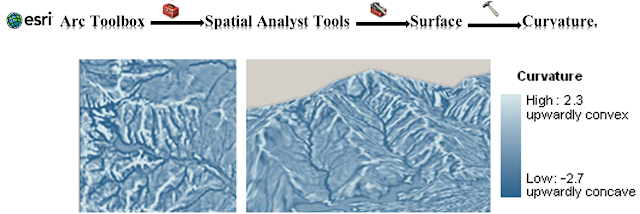













It’s really great information for becoming a better Blogger. Keep sharing, Thanks. For more details to visit Digital Terrain Model.
ReplyDeleteGreat Blog,Thanks for sharing such beautiful information with us.... For more visit Digital Elevation Model
ReplyDelete"This is exactly the kind of content I was looking for. Your post was not only useful but also very well-structured. Great job!"
ReplyDeletecapricorn stone
dataset
ReplyDelete